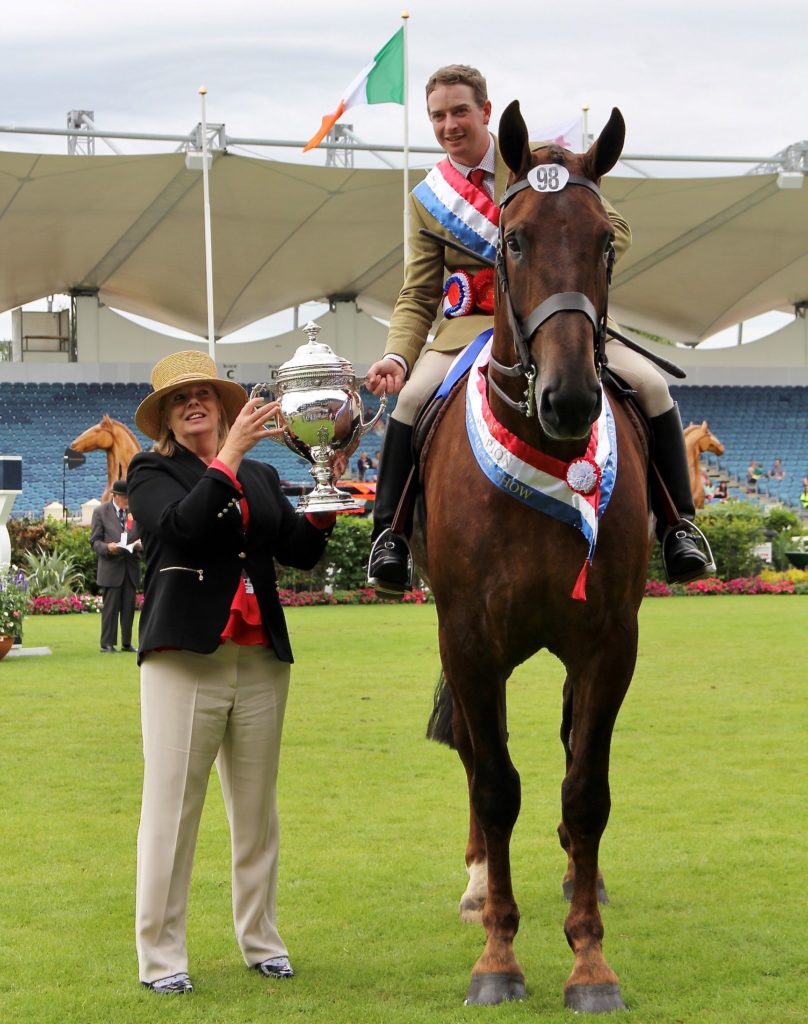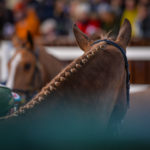BRIAN MURPHY: Producing horses for the show ring
- 9 February 2021, 17:20

2016 Dublin Horse Show Supreme Hunter Champions – Brian Murphy and Fort Knocks, 2011 Irish Draught by Gortfree Hero out of Queenies Pride by Welcome Flagmount, bred by Noel Sheridan (Photo Susan Finnerty)
For part two of our young horse training series we turn to the world of showing, and who better to speak to than showing supremo Brian Murphy.
Brian is well known and regarded at home and abroad for his judging of a young horse. During the winter months Brian can be spotted on an impeccably turned out Irish Hunter leading the Glandoran Island Hunt across the Wexford countryside – he is now in his fourth season as Huntsman. But during the summer months Brian turns his focus to producing horses for the show ring and he is rarely – if ever – out of the ribbons.
Some of Brian’s biggest achievements to date include winning the 2016 Supreme Hunter Championship at the Dublin Horse Show aboard the magnificent Fort Knocks, a 2011 Irish Draught by Gortfree Hero out of Queenies Pride by Welcome Flagmount, bred by Noel Sheridan. The Irish Draught seems to be a lucky breed for Brian – in 2017 and 2018 he won the Maxi Cob class and went on to win the Cob Championship at the Dublin Horse Show on The Peaky Blinder, 2012 Irish Draught by Rockrimmon Silver Diamond out of Larigan Coolderry Diamond by Mountain Diamond. Both horses were of course owned by Goran Hunt Horses’ Pat Loughlin and Perle O’Rourke.
Q1. Ideally, when would you begin breaking your young horses?
Brian Murphy (BM): I agree with Sarah Ennis’ advice from last week, the ideal time would be during the summer months of their three-year-old year.
Q2. Assuming your four-year-old’s season will start with Balmoral Show in May, how far in advance would you start their preparation?
BM: Once the horse is backed, I would usually just do a small bit with them initially before turning them out for a break. I’d generally bring them back in once the hunting season finishes, around February time.
To get my horses fit I would just have them hacking for a few weeks, I’m not a fan of overdoing it in the arena. The Peaky Blinder for example, the first year we had him I did all the exercising of the hounds with him during the summer that was all the prep that he got, I didn’t do a whole lot in the arena with him.
I would also maybe bring them to a few training shows, just to ride them in the warm-up or walk about so that they get used to a bit of noise and atmosphere. Riding past other horses and seeing other horses coming toward them – that’s nearly the biggest thing to try and familiarise a young horse with.
I’m very fortunate to be based near Marion Hughes yard so, when Covid-19 wasn’t an issue, I would often get my horses up there for a change of scenery. But I think hacking and getting out of the arena is the best thing you can do for a young horse because they are going to see a lot more that way and even when you’re hacking try take different routes, change it up for them.
Q3. How would you know if a four-year-old is ready for Balmoral?
BM: When considering entering a young horse for Balmoral it really will depend on how well that horse has taken to its work, mentally more so than physically. If you have a nice four-year-old who is relaxed and confident in their work then you would probably aim for Balmoral in May and then give that horse a bit of a break afterward with the aim of doing two more shows before Dublin to keep the horse fresh and enjoying the job.
I don’t like over showing horses, especially young ones, I would also try to space out shows as much as possible.
Q4. In terms of weight and condition, what do you look for in a horse, what advice would you have?
BM: When I look at a horse, I think ‘Could it go and do a job in the morning?’.
Think of a hunter at the start of the season – that’s the kind of condition you want, that you know he is fit enough to go and do a day’s hunting and he won’t be heaving after a bit of a gallop. I don’t like to see a horse overweight – it doesn’t do the horse’s health any good for starters.
Over feeding can lead to developmental problems in young horses and foals especially. The RDS actually brought in a rule a few years ago for the Dublin Horse Show that young horses must be shown in an ordinary in-hand bridle and not a double bridle which I think has really helped because if you have a horse pumped up on concentrate feed you won’t manage them in that type of bridle – I think that was a very good move.
In terms of feeding advice – talk to an expert nutritionist. Every horse is different and will have different requirements.

Brian Murphy and The Peaky Blinder, back-to-back winners of the Cob Championship at the Dublin Horse in 2017 and 2018, pictured Autumn Hunting with the Glandoran Island Hunt (Photo: Caroline Mullen)
Q5. Would you see riding a young horse as a disadvantage in showing competitions?
BM: Fort Knocks was five when we won the Hunter Championship in Dublin and he hadn’t done any shows as a four-year-old. He competed at Balmoral at the beginning of his five-year-old year with PJ Casey and we got him after that. We won the Championship at Clonmel and went on to Dublin after that, so no I wouldn’t see riding a young horse as a disadvantage.
Knowing your young horse well is a big part of it, knowing how to get them ready and keep them relaxed, how much of a warm-up they need etc.
Q6. In terms of movement what would you look for in a horse?
BM: I wouldn’t be mad on extravagant movement, I would rather a horse that covers the ground economically coming from behind and through the shoulder. Everyone likes a good mover, but a big flamboyant trot wouldn’t do it for me I’d rather more of a workman’s trot.
Just remember, a horse’s way of going can be improved but you can never alter conformation.
Q7. What advice would you have in terms of turnout of the horse?
BM: Well the first thing that appears when a horse arrives in the yard is a scissors and the tail is trimmed straight away. I like a tail that’s just to the hocks when the horse has its tail raised. Don’t clip the top of your horse’s tail, a pulled tail looks much better.
Not too many plaits – if you are in the teens when you count up your plaits you’ve gone too far. Six or seven plaits is ideal. If you have a horse with a short neck maybe add in two or three extra.
Shoeing is big thing for me too, in the summer I would always choose an aluminium plate rather than your normal shoe. The aluminium in much lighter and I just think a horse will move a bit better in them.
Q8. What advice would you have for riders when showing their horse in a group?
BM: First thing – get your space It doesn’t really matter whether you are first or last as long as you have plenty of space in front and behind, especially when you are coming around in front of the judges, you need ample space to show your horse.
It’s no problem to adjust where you are to get more space when you are behind the judges, that’s the right place to do it but don’t get too close to someone in front of the judges and certainly don’t pass them in front of the judge.
When it comes to the gallop you really need to have enough space to be able to get into the corners and get a good shot at it down the long-side of the ring in front of the Judges, if you are just coming onto the long-side and you hear a shout from the steward to gallop on don’t panic and rush into it, keep your canter and come around and do your gallop the next time.
Q9. What advice would you have for riders if their young horse acts up during the Judges ride?
BM: If a young horse gives a little bit of a buck or whatever just know that it’s only greenness and don’t be hard on yourself or the horse. The horse will only get better with time so give the horse the benefit of the doubt.
I like to see fresh faces coming through and if I was Judging I wouldn’t have a problem with a young horse riding a bit green as long as everything else is correct in terms of conformation and movement.
Also don’t be afraid to seek feedback from the Judge after the class, they are usually more than willing.
Q10. What advice would you have for riders when training their young horse for the trot up?
BM: It’s all about practice. MHS Morning Master [a 2015 Irish Sport Horse by Quidam Junior I out of MHS Cavaliers Daughter by Cavalier Royale, bred by Sinead Brennan] who was Champion three-year-old at the Dublin Horse Show in 2018 had next to no handling until he was three.
I remember, we have a lane about three quarters of a mile long, we used to walk and trot up that three or four times each evening. I used to walk all over the place with him and it just got him to the point where he was really on the button and knew when it was time to go – it’s all practice.
Q11. What advice would you have if riders are asked to perform an individual ridden show?
BM: Generally in the Hunter classes an individual show isn’t required but if you are asked to do one my advice is keep it short and sweet, a short trot and canter on both reins and that will give the judge a fair idea.
Q12. What is the difference between a ‘Riding Horse’ and a ‘Show Hunter’?
BM: The easiest way to describe a riding horse is it tends to resemble a large show pony – a real pretty, quality type. Riding horses are usually separated into two classes – small riding horse and large riding horse, that’s just based on height. In Ireland we don’t really have hack classes, they’re very popular in England but a hack would be the equivalent of a riding horse type.
Show Hunters would have a bit more substance and bone than a riding horse. Sometimes there might be a little bit of crossover between a lightweight hunter and a large riding horse, it all depends on the quality of the horse.
Q13. How would you decide on a weight division for your Show Hunter?
BM: The deciding factor here is the amount of bone the horse has. As a benchmark, if your horse has 9.5 inches of bone then it’s a middleweight, anything below that is a lightweight and anything above that would be a heavyweight.
But you need to consider the overall look of the horse too – some horses measure more bone than they look, you’d often have a true heavyweight horse based on the bone measurement but he looks real blood so you would take that into consideration too and maybe put them in the middleweight class – warmbloods can be a little bit that way.
Another way to think about it is a lightweight would be a nice horse for a lady to go hunting on and a heavyweight then might be more suited to a tall man.
Q14. Working Hunter is open to different breeds and types, assuming the horse has good jumping ability, conformation and movement is there any particular breed or type that you find tends to excel in this class?
BM: There’s no real breed that has an advantage in this class, but the horse needs to be a hunter type.
Assuming you have a horse that can jump, and the horse has good movement and conformation then it all boils back down to the type. In Dublin there are two sections lightweight and heavyweight, so if you have a middleweight horse that’s very quality then he would be better suited to the lightweight section, if you had a middleweight that was more on the strong side then he would be best suited to the heavyweight.
Q15. How would you describe the market for Irish Show Hunters and Riding Horses?
BM: Last year was an exceptional year for selling Irish horses, I know Brexit is a worry but hopefully the creases will get ironed out and it will make things easier for people to continue selling horses abroad. England is probably the main market but you’d often get interest from America and the likes of Holland.
I think the Irish draught and hunter types are so popular that they are almost hard to find now. Many will go on to show for a few seasons or are bought as hunters or nice amateur all-rounders.
Fort Knocks sold at Dublin and the week after he was on his way to Holland, he was bought as a hunter. Morning Master is with Robert Walker and Jill Day showing in England, again he was sold after Dublin and they subsequently bought his two full brothers from the Brennans. One of the brothers is rising three now and they think a lot of him.
-
Popular

-
Latest





























